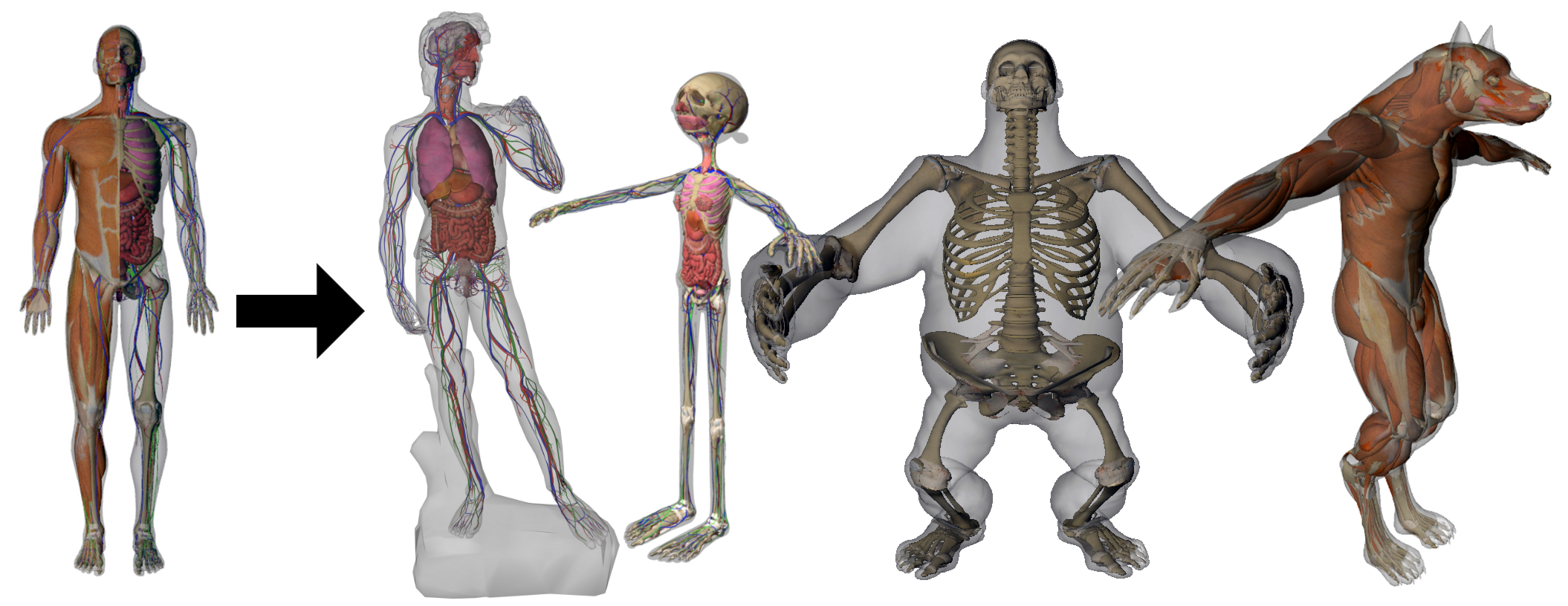Section: New Results
High level model for shapes
Implicit modeling
Participants : Antoine Bégault, Adrien Bernhardt, Marie-Paule Cani, Mohamed-Galal Koraa, Cédric Zanni.
Implicit surfaces are an appealing representation for free-form, volumetric shapes. In addition to being able to represent shapes of arbitrary topological genius, they have the ability to be constructed by successively blending different components, which eases interactive modeling.
In collaboration with Loic Barthe in Toulouse, we contributed to a new binary blending operator, called Gradient Blending [7] , which enables us to blend implicit shapes not only in function of their field values but also of their gradients. This solves a number long standing problems in implicit modeling: we can generate bulge-free blending, ensure that the topological genius of the blended shape remains the one of the union of the input one, and avoid the blur of small details.
Within Cédric Zanni's PhD [2] we introduced closed-form solutions for convolution surfaces along helical skeletons and extended Gabor-noise texturing to enable the creation of repetitive geometric details along implicit surfaces. We also developed a novel extension to convolution surfaces, so-called SCALe-invariant Integral Surfaces (SCALIS) [15] , see Figure 4 . Thanks to their scale invariant blending properties, these surfaces have three main advantages: the radius of the surface around a skeleton can be explicitly controlled, shapes are self-similar regardless of the scale of the model, and thin components are not smoothed-out when blended into larger ones. This is done while preserving the main benefits of integral surfaces, namely n-ary blending with a simple plus, and shape preservation whatever the way the skeletons is spit into smaller primitives. We are currently extending this work to enable the topology of the implicit surface to always reflect the one of the skeleton
Analysis of CAD models
Participants : Francois Faure, Stefanie Hahmann, Jean-Claude Léon, Olivier Palombi, Flavien Boussuge, Ahmad Shahwan.
CAD models, as part of assemblies defining manufactured products, are often shaped in accordance with their physical counterpart. However, one can observe that the shape of some components, as modeled in CAD, may differ from that of their physical instance. In addition, assemblies representing products are most often reduced to a collection of CAD models representing each component and the designation of each component is neither a reliable information nor a faithful connection with one or more functions of a component. As a result, geometric interfaces between components are unknown and they cannot be reduced to contacts. Interferences may exist that are also relevant for several applications. Determining precisely, the geometric interfaces between components is a first requirement to enrich geometric models with functional information because a subset of functions derive from interfaces between components.
As an example, this is particularly useful for structural mechanics to be able to generate rapidly a Finite Element model of assemblies and it is especially critical when assemblies get very complex. [9] addresses the problem to generate automatically a class of geometric interfaces for very complex assemblies (see fig. 5 ). GPU-based algorithms have proved suitable to obtain reliable results on CAD models.
Using these geometric interfaces as well as the newly introduced concept of conventional interfaces, [6] , [4] and [11] , [12] , [19] have proposed an approach using qualitative reasoning, ontology reasoning to connect CAD components, their geometric interfaces, to functions and functional designations of components: an intrinsic identifier of a component in an assembly that connects it to its function. As a result, it is shown how geometric models of components need to be restructured, which extends the concept of annotation presently reduced to a elementary link between geometric models and symbolic information.
At the level of assembly components, shape analysis [30] is particularly useful to generate dimensionally reduced models needed for structural mechanics. [3] shows that analyzing a B-Rep CAD model to derive a construction graph, i.e. a set of construction trees, can be a robust basis to generate dimensionally reduced models [18] , [32] .
Knowledge-based shape transfert
Participants : Marie-Paule Cani, Ali Dicko, Francois Faure, Olivier Palombi.
Characters with precise internal anatomy are important in film and visual effects, as well as in medical applications. We have proposed the first semi-automatic method for creating anatomical structures, such as bones, muscles, viscera and fat tissues [5] , as illustrated in 6 . This is done by transferring a reference anatomical model from an input template to an arbitrary target character, only defined by its boundary representation (skin). The fat distribution of the target character needs to be specified. We can either infer this information from MRI data, or allow the users to express their creative intent through a new editing tool. The rest of our method runs automatically: it first transfers the bones to the target character, while maintaining their structure as much as possible. The bone layer, along with the target skin eroded using the fat thickness information, are then used to define a volume where we map the internal anatomy of the source model using harmonic (Laplacian) deformation. This way, we are able to quickly generate anatomical models for a large range of target characters, while maintaining anatomical constraints.




